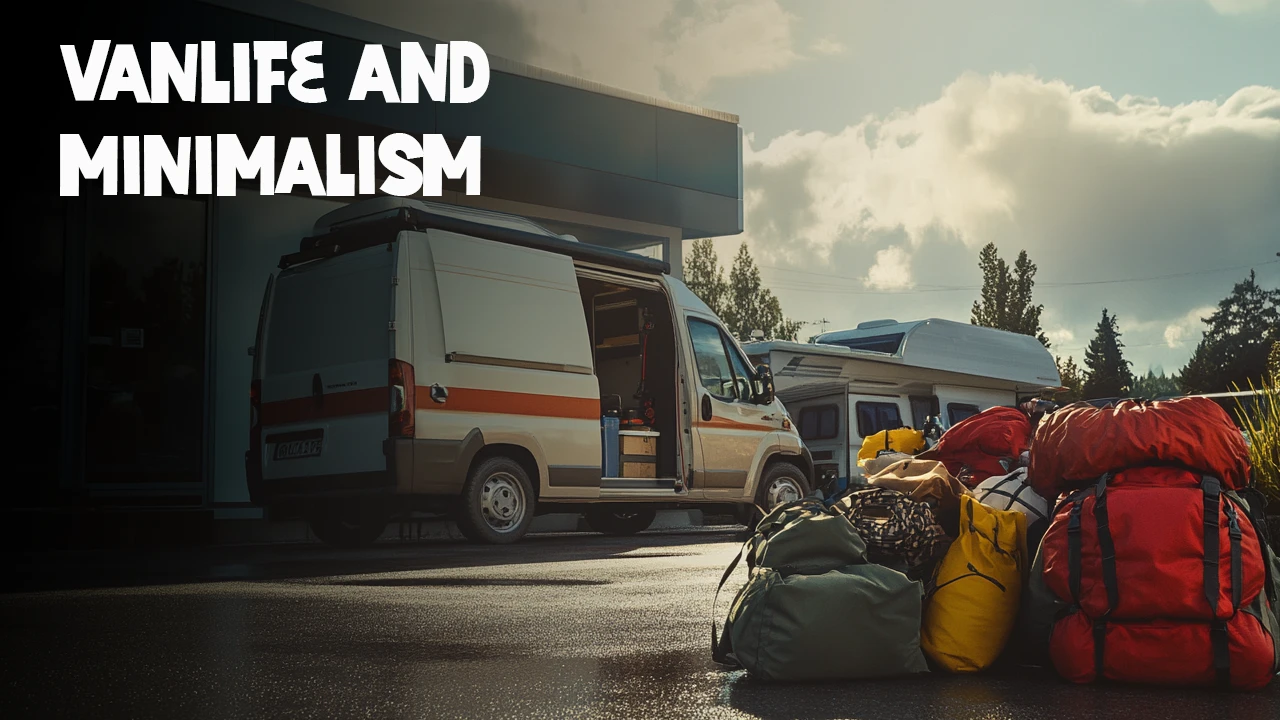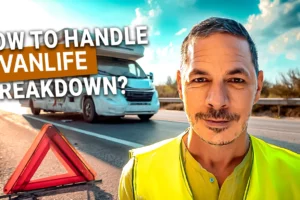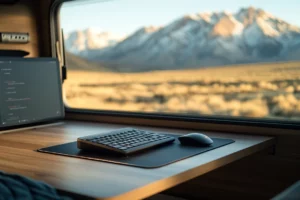
Vanlife and Minimalism: Making the Most of Your Space
Introduction
Between the urge to travel light and the near-impossible challenge of fitting in all your stuff, you’re probably dreaming of an interior as smart and satisfying as a game of Tetris.
Here’s the deal: with a well-thought-out layout and some ruthless decluttering, you can free up space—and clear your head at the same time. We’re talking real, practical solutions here: modular furniture, clever storage tricks, and embracing the essentials.
What’s in it for you? Thousands of miles on the road, feeling clear and calm, in a van that breathes freedom with every turn.
Why Minimalism Is Your Best Co-Pilot in Vanlife
People often think vanlife is just about being organised. But really, it’s about mental load. When your entire life fits into a few square metres (i.e. ft²), your thoughts need breathing room too. That’s where minimalism comes in: the less you own, the more you create—and the easier it is to breathe.
After a few weeks on the road, vanlife naturally takes over your mind. You think about water, the weather, your route, the people you meet, the beauty around you… And gradually, you feel less attached to stuff. Minimalist? Sure. Monk-like? Definitely not. The goal isn’t to live with nothing—it’s to live with what truly matters *to you*.
Living Light—Not Empty
There’s a difference between living light and living in lack. Minimalism isn’t about throwing everything out—it’s about keeping what you actually use, what brings you comfort, or what’s vital for your lifestyle. And that’s different for everyone.
What’s essential for one person might be completely unnecessary for another. What seems crucial at 25 might feel excessive at 55. A solo hiker and a travelling family won’t have the same priorities. And that’s the whole point—your minimalist setup should reflect your real needs.
Clearing Your Van—and Your Head
Visual clutter is a sneaky mental drain. All those scattered items? They pull your focus and wear you out. In contrast, a clean and tidy space calms your brain. It’s not just about looking nice—it’s mental hygiene.
In a van, this effect is even stronger: every misplaced or visible item draws the eye… and stresses you out. Less clutter = fewer distractions, which means more peace of mind. And that peace matters—especially when you’re driving for hours, or stuck inside on a rainy day.
Decluttering Before You Go: Where to Start?
The key question isn’t “Do I like it?”, but: “How often will I actually use it?”
Daily? Weekly? Once a month? And if it’s rare:
– Can I find it easily on the road?
– Could I replace it if needed?
If the answer’s “no” to both, it probably doesn’t need to come with you.
The best time to sort things out? *Before* you leave. Once you’re on the road, it’s just harder to manage. The most effective method? Sort by category—clothes, kitchen gear, tools, leisure stuff, keepsakes.
A practical example: a down jacket in winter? Sure. But heading to southern Portugal in summer—do you really need it? On the flip side, that odd spare part, niche tool, or even a self-defence item might rarely be used… but you’ll be glad to have it when the time comes.
In short: it’s not about how often you use it, but how important it is when you do.
Smart Storage: When Every Inch Matters
How much you can optimise depends on your van. If you’re converting it yourself, you’ve got total freedom: bench seats with built-in storage, hidden drawers, overhead compartments… You can tailor every inch to your routine.
But if you’ve bought a ready-made van or camper, most layouts are already cleverly designed—and too many tweaks can mess with safety or certification.
That said, there are still easy wins: vertical storage, compartmentalised bags, cupboard organisers. What matters most is that everything has a clear place—and gets put back. Otherwise, you’ll end up buried in clutter by the end of week one.
Want to travel light without sacrificing comfort? Then think smart: every item you pack should serve more than one purpose. That’s the foundation of practical minimalism—and the secret to keeping your van liveable, even on long trips.
Take the obvious example: your smartphone. It can replace a GPS, a camera, a travel guide, a flashlight, a paper map, a radio, an alarm clock, a Wi-Fi hotspot (via tethering), a smartwatch… and even a laptop if you just need to send a couple of quick emails. Basically, if one item can do the job of ten, it earns its spot on board.
And this applies to loads of other accessories: a Kindle replaces an entire bookshelf, a solid soap bar covers the job of four different liquids, resistance bands can sub for a whole gym setup. The result? Less weight, less clutter, more freedom.
So here’s our list of tried-and-tested multi-use gear. This isn’t just a checklist—it’s a real optimisation strategy, designed to help both your van and your mind breathe easier.
| Item | What It Replaces | Uses | Estimated Gain |
|---|---|---|---|
| Smartphone | GPS, camera, alarm clock, modem, flashlight, radio | Navigation, communication, info, hotspot | 📱 ~6 devices in one |
| E-reader (Kindle, Kobo…) | Paper books, guides, notebooks | Reading, PDFs, offline travel info | 📚 ~11 lbs (5 kg) for 10 books |
| Resistance bands | Dumbbells, machines, workout bench | Full workouts, mobility training | 🏋️♂️ ~17–22 lbs (8–10 kg) |
| iPad or tablet | Laptop, notebook, TV, game console | Work, entertainment, navigation | 💻 ~3–4 devices replaced |
| Compact projector | TV, external monitor | Movies, sharing photos/videos in or outside the van | 📺 ~9 lbs (4 kg) and less bulk |
| Multi-use sneakers | City shoes, hiking boots, gym shoes, flip-flops | All-purpose comfort and practicality | 👟 1–2 pairs saved (~3.3 lbs / 1.5 kg) |
| Packable fleece | Thick jumpers, down jackets | Warmth, breathable, quick-dry | 🧥 ~50% less volume |
| Compressible rain jacket | Umbrella, raincoat | Windbreaker, rain, storms | 🌧 ~0.9 lbs (400 g) + saved space |
| Marseille soap / solid shampoo | Shampoo, shower gel, laundry soap, dish soap | Body hygiene, clothes, dishes | 🧼 ~4 bottles avoided |
| Microfibre towels | Traditional terry towels | Fast-drying, compact, lightweight | 🧽 ~75% space saved |
| Collapsible silicone dishware | Bowls, mugs, salad bowl | Compact, practical mealtime setup | 🍲 One full drawer freed |
| Multi-use stainless cup | Coffee mug + water glass | Hot and cold drinks | ☕ ~50% fewer dishes |
| Water filter bottle | Plastic bottles, water packs | Safe drinking water anywhere | 💧 ~4.4 lbs (2 kg) of water transport avoided |
| Compression bag | Hard bins, regular duffel bags | Clothes, duvet, towels | 🎒 ~60% less volume |
| 12V universal charger | Multiple chargers, adapters | Phone, e-reader, tablet, power bank | 🔌 ~3–5 cables saved |
| Multi-tool (like a Leatherman) | Pliers, knife, screwdriver, scissors | DIY fixes, emergencies, hiking | 🛠 ~1.1 lbs (500 g) of tools |
| Modular pillow | Pillow, throw blanket, light quilt | Day/night comfort, extra warmth | 🛏 ~1 sleeping bag saved |
| Adjustable weighted vest | Dumbbells, sandbags | Strength training without gym gear | 🎽 ~22 lbs (10 kg) avoided |
The Art of Optimisation: When Every Inch Has to Pull Its Weight—Smartly
Minimalism isn’t about piling up storage bins. It’s about designing your space so it actually works—in real life, when you’re on the move, under pressure, or dealing with the unexpected. In a van, it’s not just about tidying up. It’s about logic, safety, and practical comfort.
And above all, everything needs a place—and it should stay there. If you have to move a bag, a box, or your clothes every time you want to use the shower, your layout isn’t working.
A Well-Designed Space Doesn’t Waste Your Time
Most common mistake? Putting one thing in front of another.
You need to get to the bathroom, but first you have to shift the dish crate?
You want to lie down, but your bench is taken up by your backpack and shoes?
That’s a sign your setup isn’t matching your real-life routine.
Ideally, you should never have to move one item to reach another. The stuff you use daily should be instantly accessible. Everything else? It can live deeper in storage—or even outside, depending on its use.
Safety First: Think Reflex, Not Effort
Picture this: it’s 11 p.m., you’re in bed, and you hear something outside.
If you have to stumble across your van to grab your safety spray or headlamp, that’s a serious design flaw. Critical items should be within arm’s reach, no thinking required.
Same goes for your fire extinguisher, first aid kit, or vehicle documents. Think of them like an emergency button: you should know where they are and get to them instantly.
Logical Storage = No Wasted Energy
Your setup just needs to make sense:
- 🧼 Shower products? Keep them *in* the shower. No need to haul them back and forth every time.
- 👟 Shoes? Store them inside if you put them on inside. Don’t leave them in a wet bin outside.
- 🧰 Water hoses or hookup cables? Outside, in a dedicated box or compartment.
In a well-organised van, you’re not asking yourself, “Where’s my charger?” or “Where did I put the sponge?” every five minutes. Everything’s right where you expect it to be. No fuss.
You’re Not Throwing a Dinner Party—You’re Living Off-Grid
You don’t need 8 plates “just in case.” Most people you meet on the road will have their own gear. And for the 300 days when you’re alone? You’ll just be lugging extra stuff around for no reason.
Same idea for dishes, towels, mugs: two of each is plenty—one for you, one for a guest. Anything more is just pointless “what-if” packing.
Smart Packing Means Thinking Ahead—Not “What If?”
The real luxury in vanlife isn’t having everything with you. It’s being able to access what you need, when you need it, without it getting in the way. That comes from invisible, seamless organisation: everything has a home, nothing blocks your movements, no drawer or door is obstructed.
When you can shower, sit, cook, sleep, or hit the road without moving a single extra thing—that’s when your van is truly optimised.
Minimalism Also Means Rethinking Daily Consumption
Vanlife isn’t just about owning less—it’s also about rethinking how you consume: how you plan, store, and manage resources to avoid stress, waste, and unnecessary expenses.
Plan Your Water Use to Avoid Pointless Stops
Even if your van has a 100-litre tank (i.e. approx. 26 gallons), that doesn’t mean you need to fill it up every time. What matters more is knowing when and where you can refill. If you’ve got a couple of urban stops lined up with access to showers or bathrooms, you can skip a fill-up and drive lighter.
Best tip? Use a vanlife app or a water-point map (like Park4Night, Campercontact…) to track what you’ll actually need. A lighter van = better mileage, smoother driving, less stress.
Smart Food Staples So You’re Not Relying on Daily Fresh Shopping
Daily markets are nice—but not always convenient. And when you’re in the middle of nowhere, you’ll be glad to have some long-lasting food options on hand. The best setup? A balance:
- 🧄 Fresh produce for same-day meals (fruit, veg, local bread)
- 🥫 Homemade or organic canned goods (beans, sauces, soups)
- 🌾 Dry bulk staples (rice, pasta, oats, seeds)
Also stock up on long-life snacks like nuts, dried fruit, and packaging-free energy bars.
Bulk Shops, Jars, and Fabric Bags: Your On-the-Road Grocery Kit
Why buy five 500g packs when you could fill a 5kg (i.e. approx. 11 lbs) jar once? Bulk stores quickly become your best friend. A fabric bag, a couple of solid jars, and a small crate, and you’ve got a low-waste shopping system.
Think compact when it comes to carrying and storage: cloth bags, stackable containers, insulated bottles. Result? No leaks, no pointless packaging, and a well-organised van.
Homemade Cleaning Products: Eco-Friendly, Light, and Cheap
One bottle of white vinegar will clean your kitchen, floors, and toilet. Add some baking soda and lemon, and your dishes sparkle—no harsh chemicals needed. You’ll save around 15€ (i.e. approx. $16 or £13) and three shelves by replacing five typical household cleaners.
And for hygiene?
- 🧴 Solid soap for body, hair, and dishes
- 🧼 DIY deodorant with just 3 ingredients and zero waste
- 🧴 Organic plant oil = face cream + hair care + massage oil
Altogether, you can easily swap out 7–10 products for just 3 essentials. In 6m² (i.e. approx. 65 ft²), that makes a huge difference.
Repair Kit: Avoid Emergency Purchases
A busted seam, loose velcro, or cracked mug can happen any time—so keep a mini repair kit on hand:
- 🧵 A compact sewing kit
- 🔩 Fabric repair tape
- 🪛 Universal glue or hot glue stick
The result? About 85% of small problems solved on the spot, no shopping runs, no delays.





